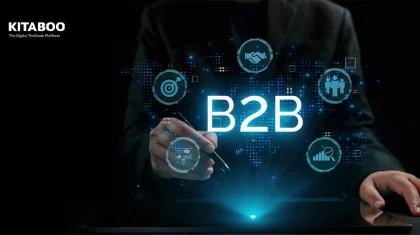
6 Best Video Formats for Corporate Training
YouTube is a perfect example which confirms the importance of video content in the present era. People view more than 500 million hours of video each day on YouTube, this indicates the exponential rate at which video content is being consumed. This rising trend has forced L&D teams to introduce training videos in their corporate training programs. The numerous variations in content and the presentation style has given rise to different types of video formats. And choosing one out of the many video formats for corporate training could prove to be quite a demanding task. Because you need to analyze which format would be most effective in training your employees.
Sometimes, certain topics require a specific kind of video format to explain it better. For example, if you are training medical students on how to perform a surgery, you can’t just do that with an explainer video, they need to see a demo of the procedure. So, before developing content for the training video, corporate trainers must put some thought into the kind of video that would be most effective for their audience.
Here are five best video formats for corporate training that you can include in your employee training program:
Animated Video to Increase Retention Rates
Let’s start with the most interesting form of video available today. Animation holds a certain charm which makes us connect with it. Disney and Pixar are making billions from their animated movies, and most of the audience are adults! Enterprises are opting for animated videos to deliver corporate training because they hold more retention value. With the help of animation, you can convey complex concepts with ease, and also add a bit of humor to it. It allows you to be as creative and quirky as you want.
With animation you can show serious stuff in a lighthearted manner without making it look gross and unpleasant, and also ensure that the message is strongly conveyed to the employees. It can be used for induction, onboarding, soft skill training, product and process training as well. Animated videos keep the viewers engaged and helps them in recalling the information when required.
Talking Head Videos to Share Expertise
A talking-head video is one where someone is talking to the camera. Think of instructor-led training, which is probably the oldest form of teaching. While this traditional mode of training is still quite effective, it is slowly shifting its medium from classroom to mobile devices. This style of training is particularly useful when the instructor wants to explain something in detail.
Although with a talking head video, there’s a risk of people finding it boring. Think about it, you are constantly looking at someone talking on the screen. How long do you think this speaker can hold the viewer’s attention? Hence, in order to keep it interesting, we suggest you include other elements in between, such as illustrations, stats and graphs etc., just to break the monotony. You could also allow multiple people to feature in the video. Mixing it up with more elements will help make it engaging. While creating a talking head video you need to keep in mind that there should be a natural flow to the message, it should not sound like someone is reading from a script. Ask an SME to feature in the video or someone who is really knowledgeable about the subject matter, it will help employees connect with the video.
Demo Video to Give a Clear Idea of The Work Process
When you want to find out how something works, you generally go to YouTube, where you get step by step demo of the process. When you want to explain something by showing the audience how it works, it’s best to go for demo videos. Watching a live demo helps in understanding the process much better than just listening about it. If you show your employees how to operate a machinery before letting them have a hands-on experience, they would be better prepared to work on it.
If you are a sales firm, trying to explain to your employees how to pitch your product, show them a demo video of how it’s done, and also demonstrate how your product functions. This will give them better understanding than mere theoretical knowledge. Because unless they are completely aware of its features they cannot sell it convincingly. In a demo video, you are performing an act while explaining it. So, you need to be prepared in advance with all the right tools required to get the job done.
Simulation for a Realistic Training Experience
Simulation videos are a great way to ensure that your employees clearly understand and remember the information. This is an interactive form of training video which enhances one’s critical thinking skills. Employees are given a scenario where they have options to choose from. According to the option that is chosen, the next scene will play out. For example, if the scenario is about dealing with an irate customer on telephone, the options could include- giving immediate solution to the customer, getting help from a colleague, or disconnecting the call. With the help of rich computer graphics and animation, you can create a virtual design of almost anything, say for example, a dismantled engine, and the learner can choose which part goes where, how to re-attach it etc.
The best thing about this kind of training is that it’s completely safe. Even if you mess up or give wrong answers multiple times, neither you nor your company is going to suffer. It makes for a good trial and error exercise. So, without any loss of reputation or money, you are giving your employees a chance to make wrong decisions and learn from it.
Screencast for Software Training
While all the other forms of video training can be used for teaching almost anything, screencast is specifically meant for software related training. Screencast records the instructor’s screen, capturing every step that the trainer performs on his computer. This helps learners to see and learn how to use a specific software. For example, if someone wants to learn how to create pivot tables in MS Excel, the screencast video shows a step-by-step process. This can be accompanied with audio to explain it better.
It is not possible for a corporate trainer to keep taking frequent sessions on how to work on a particular software. Screencast on the other hand, is like a constant tutor, whom the employee can rely upon and is always available. Whenever the employee feels unsure about working on a particular tool or software, they can watch the step by step instructions given in the video. After re-watching the video if the learner has any queries he can ask the trainer. This becomes a convenient process for the trainer and the trainee. This is probably the least expensive and cost-effective form of video available. Because all you need is a software to be installed on the trainer’s screen. These online tutorials help the learners to watch and practice.
Summary Video for Quick Viewing
These are short videos apt for on-the-go employees. Summaries are shortened versions of a particular topic. A summary video comes handy when the employee wants to have a quick look at the information while commuting, during breaks etc. Providing a summary video offers just in time information and helps your employees to stay updated or brush up their knowledge anytime they want.
Corporate training videos have evolved from being just PowerPoint slides clubbed together, to a more dynamic platform, where customized videos are created for each training requirement. Social media has changed the way we consume content. Viewers are said to retain 95% of a message when they watch it on video compared to 10% when reading it in the text. Hence, enterprises are creating different video formats for corporate training. Video-based learning works mainly because of its ability to keep the viewers engaged. And corporate training programs need to maintain a certain level of engagement to keep their employees motivated. Hence, L&D teams are designing and delivering different formats of video for corporate training to increase employee efficiency.
Related: Guide on How To Create Great Video Training Content
Discover how a mobile-first training platform can help your organization.
KITABOO is a cloud-based platform to create, deliver & track mobile-first interactive training content.


